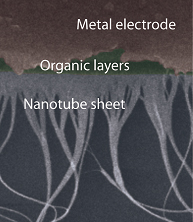Home > Press > High Performance OLED on Carbon Nanotube Electrodes
High Performance OLED on Carbon Nanotube Electrodes
Posted on May 09, 2006
Researchers at the Regroupement Québecois sur les Matériaux de Pointe (RQMP) in Québec, Canada have assembled an organic light emitting diode (OLED) that uses thin and conductive single wall carbon nanotube sheets as the transparent electrode. The performance of their electrode rivals that of the transparent conducting oxide - indium tin oxide - currently used in commercial applications. The demonstration of this new technology recently appeared in the May online issue of Applied Physics Letters.

|
Schematic of the OLED device fabricated on a carbon nanotube electrode (above) and image of the device revealing the carbon nanotube fibers that compose the fabric-like sheet electrode (below).
|

|
Organic light emitting diodes have in recent years emerged as a promising low cost technology for making large area flat panel displays and flexible light emitting fabrics. However, the fabrication of flexible OLEDs has up to now been held back by the fragility of the brittle indium tin oxide layer that serves as the transparent electrode. Constant bending of this layer unavoidably leads to cracking and device failure. By using carbon nanotubes, a highly conductive and flexible tube shaped carbon nanostructure, thin sheets a few tens of nanometers in thickness can be fabricated following a procedure akin to making paper. These sheets preserve the conductivity and flexibility of the carbon nanotubes and are thin enough to be highly transparent.
By following the fabrication procedure they developed, the researchers succeeded in producing a high-performance OLED on this new electrode material. In their work they also outline the parameters that can be further optimized in order improve the performance of their design. "In addition to their flexibility, carbon nanotube sheets exhibit a number of properties that make them an attractive alternative to transparent conducting oxides for display and lighting applications," says Carla Aguirre, the leading author of the paper. "By applying the appropriate chemical treatment they can in principle be also made to replace the metal electrode in order to make OLEDs that emit light from both sides."
To learn more, refer to the scientific article: "Carbon nanotube sheets as electrodes in organic light-emitting diodes" Appl. Phys. Lett. 88 183104 (2006) or visit this link.
Richard Martel
r.martel@umontreal.ca
Copyright © Nanoscale Science and Technology Portal for Univesité de Montréal and École Polytechnique
If you have a comment, please Contact us.
Issuers of news releases, not 7th Wave, Inc. or Nanotechnology Now, are solely responsible for the accuracy of the content.
| Related News Press |
Nanotubes/Buckyballs/Fullerenes/Nanorods/Nanostrings
![]() Enhancing power factor of p- and n-type single-walled carbon nanotubes April 25th, 2025
Enhancing power factor of p- and n-type single-walled carbon nanotubes April 25th, 2025
![]() Chainmail-like material could be the future of armor: First 2D mechanically interlocked polymer exhibits exceptional flexibility and strength January 17th, 2025
Chainmail-like material could be the future of armor: First 2D mechanically interlocked polymer exhibits exceptional flexibility and strength January 17th, 2025
![]() Innovative biomimetic superhydrophobic coating combines repair and buffering properties for superior anti-erosion December 13th, 2024
Innovative biomimetic superhydrophobic coating combines repair and buffering properties for superior anti-erosion December 13th, 2024
Announcements
![]() Rice membrane extracts lithium from brines with greater speed, less waste October 3rd, 2025
Rice membrane extracts lithium from brines with greater speed, less waste October 3rd, 2025
![]() Researchers develop molecular qubits that communicate at telecom frequencies October 3rd, 2025
Researchers develop molecular qubits that communicate at telecom frequencies October 3rd, 2025
![]() Next-generation quantum communication October 3rd, 2025
Next-generation quantum communication October 3rd, 2025
![]() "Nanoreactor" cage uses visible light for catalytic and ultra-selective cross-cycloadditions October 3rd, 2025
"Nanoreactor" cage uses visible light for catalytic and ultra-selective cross-cycloadditions October 3rd, 2025
|
|
||
|
|
||
| The latest news from around the world, FREE | ||
|
|
||
|
|
||
| Premium Products | ||
|
|
||
|
Only the news you want to read!
Learn More |
||
|
|
||
|
Full-service, expert consulting
Learn More |
||
|
|
||








